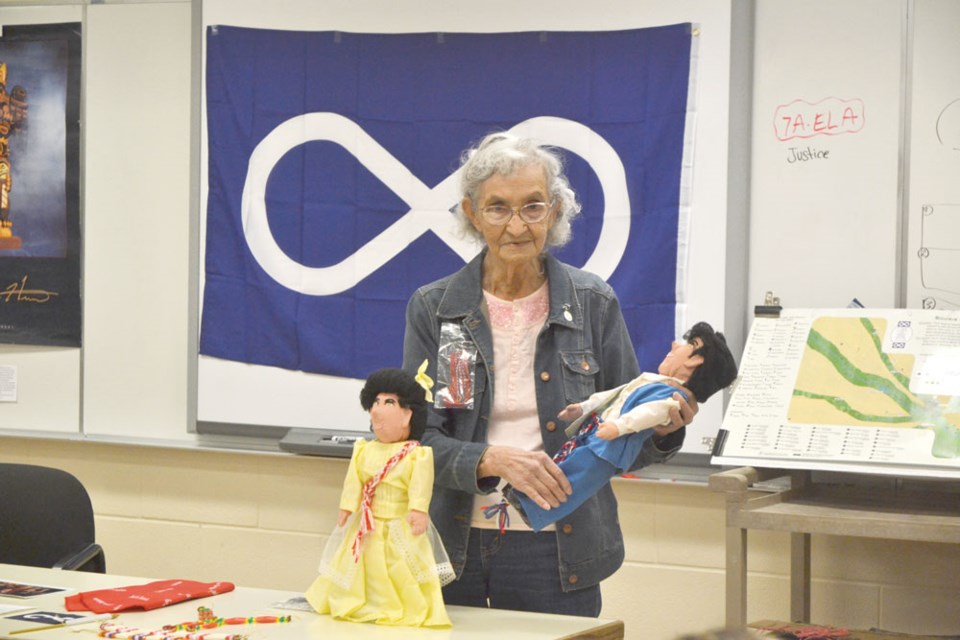Guests to a Métis history event hosted by Southeast Newcomer Services at Spruce Ridge School took a trip back in time, and learned about some of the rich Métis history in the Souris Valley region, on Feb. 28.
Guests packed a classroom at the school to the brims to listen to a series of historical accounts from Christina Blondeau, a Métis elder, about her past and memories of the Métis way of life, long ago, where Estevan is now found.
Blondeau created a vivid picture of what life was like for the Métis living in southeast Saskatchewan, from the 1930s onward, her account going back to her childhood, living in houses made from whatever material could be found on the land.
Blondeau most vividly told guests about life for three Métis families living along what would become the southern edge of Estevan, at the edge of the valley. Life was far different, she noted, in those days, involving a great deal of work to remain self-sufficient in the Prairies.
What we did for food was whatever we managed to do on our own. Hunting, whatever grew in your garden, and wild fruit,” said Blondeau. “We grew up to be strong, and learned very early, to adapt to all sorts of situations in our lives.”
Blondeau said that growing up, there never was a want for drinking water, with plenty of springs being available to her family and others, in the area around the Souris River.
Since there was nowhere to buy tools, domestic wares or toys, Blondeau said everything her family had, from the wooden dishes they ate out of to the dolls she and girls like her had, were all homemade and handmade.
In her account, Blondeau noted that even religious rites were a challenge to the Métis, and recalled a trip some of her relatives made to the village of Lebret, from Estevan, just to baptize newborn family members, at what was the closest church to where they lived.
Blondeau also recalled another exhaustive journey her father went on, to confirm the Canadian identity of a man who wanted to claim a pension from the government, who’d been serving as an early border guard in the area. The travels of her father brought him from what is now Estevan to the Regina area, Winnipeg and eventually what is now Brandon, all just to find relatives to the old border guard, to confirm his Canadian citizenship.
Blondeau said he performed the entirety of that prairie-spanning journey on foot. Such long, arduous treks were simply a fact of life, at the time.
One of Blondeau’s fondest memories was of her discovery of a pony on a range, her efforts to save up enough money to ask the owner to sell it and the eventual joy of having the pony freely given to her.
“It was the best thing that every happened to me when I was young. I‘ll never forget the man or the pony,” said a wistful Blondeau.
Blondeau, who regularly rides horses to this day, said riding became an integral part of her family and the other Métis families in the area, once horse ownership in the area became more prevalent. She recalls that in her youth, even horse ownership in the Souris Valley area was uncommon. Because of that, Blondeau said Métis families would often hitch carts to steer or cows for transportation.
Blondeau said she has lived and worked in a number of places, including Ontario, Manitoba, British Columbia, Alberta and both North and South Dakota, but that “the only place I like is Saskatchewan. I don’t holiday anywhere except Saskatchewan.”
Blondeau, in her accounts of the past, remarked how peculiar it was that it took so long, in the swing of things, for the Métis to be acknowledged in Canadian history, and that there wasn’t even a Métis flag she knew of, until around 2002.
Guests were inquisitive and attentive throughout the event, taking a great interest in a number of historical items Blondeau had on display, and asking a number of questions.
Before the formal talk ended and guests admired the old Métis historical frontier artefacts she brought with her and sampled bannock bread, a staple of the Métis diet in early times in the Prairies, someone facetiously asked: “Was Saskatchewan always this cold?”
With a knowing smile, Blondeau replied, “Most winters I remember were a lot colder than this one.”



